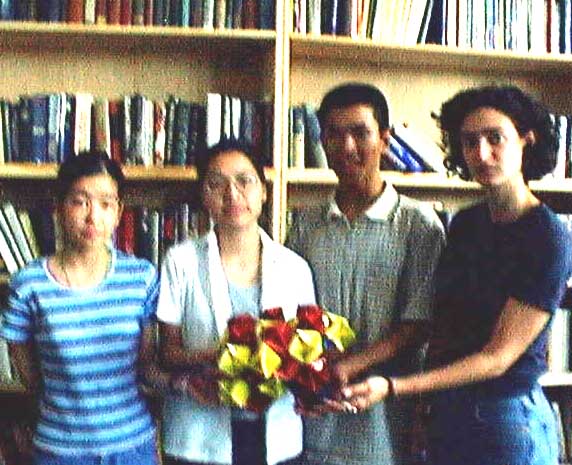
Ca10(OH)2(PO4)6

Hydroxyapatite is the primary structural component of bone. As its formula suggests, it consists of Ca2+ ions surrounded by PO43– and OH– ions.
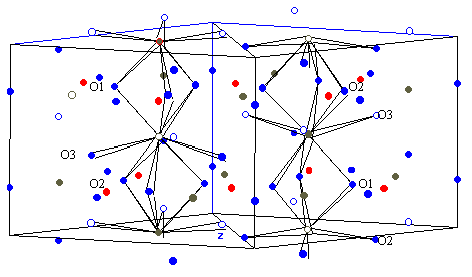
The unit cell consists of two triangular prismatic subcells forming a rhombic prism with vertical sides. There are two horizontal mirror planes, one 1/4 of the way down and one 3/4 of the way down from the top. In addition, there is a center of inversion exactly in the center of each vertical face of each subcell.
There is three-fold symmetry both looking down either of the two -Ca-Ca-Ca- stacks and looking down any of the four vertical edges of the unit cell.
Note: This means that you can add to your molecular origami model as much as you want. Just make sure that everything that you do has this symmetry and you will be on the right track.
In this first view, from the top of the unit cell,
we see a CaO9 substructure centered on Ca1.
The three O1 atoms are above the Ca atom; the three O2 atoms, slightly
twisted, are below. The three O3 atoms are slightly below the Ca1
atom in this view.
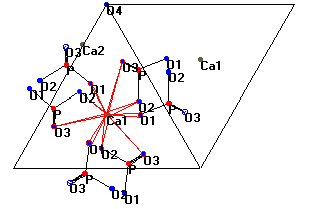
There are three such centers in each triangular subcell. One is flush with the top of the cell, one is flush with the bottom (counting 1/2 Ca each), and one is half of the way from top to bottom. Thus, each triangular subcell has 2(1/2) + 1 = 2 calcium atoms of type Ca1, and the unit cell has four Ca1 total. The side view shows the stacking of the CaO9 units:

Due to the two mirror planes in this structure, one 1/4 of the way down and one 3/4 of the way down from the top, the calcium atoms in the middle are enantiomers (mirror images) of the ones on the top and bottom faces. Notice also that the CaO9 unit on the left is the mirror image of the one on the right! (Note the open vs. opaque gray circles. These represent enantiomeric atoms.)
Note: Each molecular origami CaO9 unit consists of two distinct subunits: A/B for one enantiomer and A'/B' for the other enantiomer. Do not mix these units, as only A fits with B and only A' fits with B'. When making the model, you must stack these two kinds of CaO9 units properly! Make three of one kind and three of the other, then make two stacks of alternating enantiomers, connecting one Ca1 on top of another via their O1 and O2 atoms.
Along each of the three vertical faces of each triangular subcell there are two calcium atoms of another sort (Ca2), each with seven O atoms nearby, making a CaO7 substructure. Thus, each subcell contains 3(2)(1/2) = 3 Ca2 atoms, and the unit cell has six Ca2. Along with the four Ca1 atoms, this gives a total of ten calcium atoms in the unit cell.
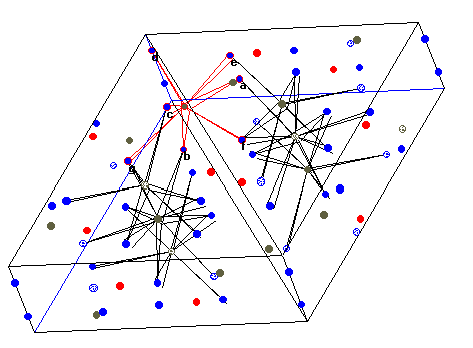
Note that these CaO7 units are effectively the glue that ties the stacked CaO9 units together. Make as many as you need to lend support to the structure (at least two).
This next figure shows the other CaO7 unit on the central triangular face of the unit cell. Note how there are on each vertical edge two special O atoms (O4). In each triangular subcell we have six of these O4 atoms shared among six triangular subcells each. There is, in effect, one of these O4 atoms per subcell (two per unit cell). These special positions are OH groups in hydroxyapatite and F groups in fluoroapatite. (The H atom of the OH is randomly distributed among different locations in hydroxyapatite.)
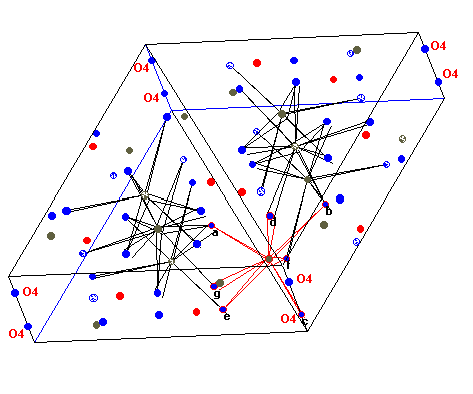
The six PO4 units of the unit cell (three in each of the two triangular subcells) are organized in sets of three in a "pinwheel" fashion around Ca1. They are attached via O2 and O3 in each case. In this depiction there are two O3 atoms aligned vertically. One is part of the enantiomeric CaO9 unit just above this one. | 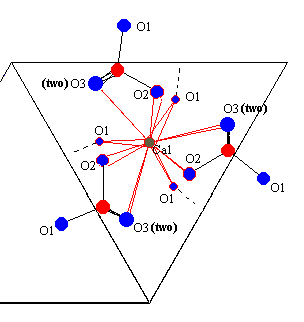 |
Note: When attaching these PO4 units, try matching the O3-O2 edges of the PO4 with the CaO9 stack in such a way that the O1-P-O2 plane is exactly horizontal. Ca, P, O2, and O3 should all lie in a single (slightly tilted) plane. Each O1 should connect with the neighboring CaO9 stack.
To construct the 150,000,000:1 model, the following subunits are recommended:
3 | |
3 | Ca'O9 subunits (enantiomers of the above) |
2 | |
12 |
| Reference: | Wycoff, Crystal Structures, 2 nd Ed. Volume 3, p. 228. | |||
| Space group: | 176 Hexagonal: P63/m | |||
| Parameters: | 941.8,941.8,688.3,90,90,120 | |||
| Ca1 | 1/3 | 2/3 | u | (u=.001) |
| Ca2 | u | v | 1/4 | (u=.246) (v=-.007) |
| O1 | u | v | 1/4 | (u=.329) (v=.484) |
| O2 | u | v | 1/4 | (u=.589) (v=.466) |
| O3 | x | y | z | (x=.348) (y=.259) (z=.073) |
| O4 | 0 | 0 | 1/4 | |
| P | u | v | 1/4 | (u=.4) (v=.369) |
The team at the Institute for Collaborative Education in NYC who created this model as part of an exhibition on aging at the New Museum of Contemporary Art in NYC.
